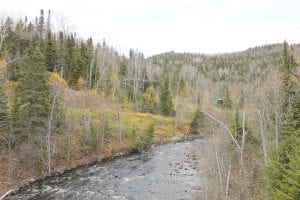Cleaning up the Poplar River has been the work of about 10 years at Lutsen Mountains and good results continue to appear. Karen Evens from the Minnesota Pollution Control Agency (MPCA) was happy to report during the most recent Poplar River Management Board meeting on Thursday, April 14 that things are moving forward in the delisting process for Poplar River.
“We did put in all the paper work for requesting a delist for moving the river from the official impaired water source list. That is still being processed,” Evens said. “I’m hoping next time we have a meeting, I will be able to confirm for you where we are at with the delisting, but they just don’t have that done yet.”
Evans also reported that watershed monitoring both upriver and in the lower Poplar River has turned up good Index of Biotic Integrity (IBI) scores.
“During the intensive watershed monitoring, we had two or three more stations upriver. The fishery report on them was good. The invertebrate report on them was good. The water chemistry was good,” Evens stated.
When asked about lower Poplar River, she said the numbers were a bit lower, but it still met the IBI scores for biology.
“We had zero impairments for biology in all of Lake Superior north, and we only had one extended impairment on a stream, which was the Flute Reed River,” Evens explained. “Otherwise, all of the waters sampled in Lake Superior north met standards or were exceedingly above the standards so much so that some streams are going to be declared exceptional use streams when that report comes out.”
After Evens’s report, Soil and Water Conservation District Manager Kerrie Berg and engineer Keith Anderson talked about a couple of ongoing projects around Lutsen Mountains.
Berg shared with the board that she had met with Ilena Berg, the county water plan coordinator, and got some ideas for a synaptic sampling program. She went on to explain the process for collecting data.
“We came up with six stations. We would get volunteers to pick a station and we would have a training day and show everyone their stations and what they are going to do, how to collect the samples,” Berg explained. “So we would do it during rain events and once every month just to be consistent, get some data, because we want to see the before and after that tributary, what the difference is.”
The goal of the synaptic test, the co-owner of Lutsen Mountains, Tom Rider, explained, is to pinpoint where sediment in the river is coming from. If an inordinate amount is going in, either from a tributary or riverbank erosion, the team will be able to determine where it is and address it.
One tributary, between the Moose and Mystery mountains, has already been identified as a problem for Poplar River and projects are under way to decrease the amount of sediment being run into the river.
Although progress has been made and the end is in sight, Rider noted that the board would still have a job to do once the Poplar River has been delisted.
“We need to maintain what we’ve achieved,” Rider stated.



Loading Comments